#Ornamental Cornices Services
Explore tagged Tumblr posts
Text
Brisbane Plastering Service
For reliable Brisbane Plastering Service, look no further than Brisbane Wide Plastering Service. Their expert team offers a comprehensive range of Brisbane Plastering Services tailored to meet your needs, whether for residential or commercial projects. With a focus on quality and precision, their Plastering Services in Brisbane cover everything from repairs to complete installations, ensuring…
#Ceiling Panels Installation#Ceiling Panels Installation in Brisbane#Drywall plaster in Brisbane#Drywall plaster services in Brisbane#Interior Lining Services#Interior Lining Services in Brisbane#Metal framing to partitions Brisbane#Ornamental Cornices Services#Ornamental Cornices Services in Brisbane
0 notes
Text
Plastering Service Australia: Professional Solutions for Every Project
Understanding Plastering Service Australia
Plastering Service Australia provides high-quality plastering solutions for residential, commercial, and industrial projects. Whether it is a new construction, renovation, or repair job, professional plastering ensures smooth, durable, and aesthetically pleasing walls and ceilings. Plastering is a crucial step in construction, affecting the final appearance and longevity of a structure. With skilled tradespeople, advanced techniques, and premium materials, Plastering Service Australia offers services tailored to meet every project’s specific needs.
Types of Plastering Services Available
Plastering Service Australia covers a wide range of services, including solid plastering, gyprock installation, rendering, and decorative finishes. Solid plastering involves applying a cement or lime-based mixture to walls and ceilings, providing a smooth and durable surface. Gyprock or drywall installation is a preferred choice for interior walls, offering a quick and efficient solution. Rendering, which involves applying a sand and cement mixture to exterior walls, enhances durability and weather resistance. Decorative finishes, including cornices, ceiling roses, and ornamental plasterwork, add elegance and character to spaces.

The Benefits of Hiring Professional Plasterers
Engaging a professional Plastering Service Australia ensures high-quality workmanship, efficiency, and long-lasting results. Professionals possess the skills and experience required to achieve a flawless finish, free from cracks, bubbles, or uneven surfaces. They use the right materials and techniques to ensure durability, reducing the need for frequent repairs. Hiring experts also saves time and effort, as they complete projects within set timelines and with minimal disruption. Additionally, professional plasterers adhere to safety standards, ensuring a secure and compliant work environment.
Choosing the Right Plastering Service Australia
Selecting a reputable Plastering Service Australia requires consideration of experience, portfolio, and customer reviews. Experienced plasterers have a proven track record and can handle various projects, from small residential jobs to large commercial developments. Reviewing past projects and customer testimonials helps assess the quality of work and reliability. It is also essential to choose a service that provides transparent pricing, detailed quotes, and a commitment to meeting client expectations. Ensuring the plastering service is licensed and insured adds an extra layer of confidence.
Trends in Modern Plastering Techniques
Plastering Service Australia keeps up with modern trends and innovations in the industry. One of the most popular techniques is Venetian plastering, which creates a luxurious and polished look with a marble-like finish. Another trend is sustainable plastering, using eco-friendly materials such as lime-based plasters that improve air quality and reduce environmental impact. Acoustic plastering is also gaining popularity in commercial spaces, providing sound insulation while maintaining an elegant appearance. These modern techniques not only enhance aesthetics but also contribute to energy efficiency and sustainability.
Maintaining and Repairing Plastered Surfaces
To extend the lifespan of plastered surfaces, proper maintenance is essential. Plastering Service Australia advises regular inspections to identify cracks, water damage, or wear. Minor cracks can be filled with plaster compounds, while larger issues may require professional intervention. Preventing moisture buildup through adequate ventilation helps protect plaster from deterioration. For painted or decorative plaster finishes, gentle cleaning methods ensure they remain in pristine condition. Professional maintenance services can address more complex issues and restore plastered surfaces to their original state.
youtube
Conclusion
Plastering Service Australia offers expertise, precision, and quality in every project. Whether for new constructions, renovations, or repairs, professional plastering enhances the beauty, durability, and value of a property. With various plastering techniques, advanced materials, and skilled craftsmanship, clients can achieve outstanding results that meet their aesthetic and functional needs. Choosing a trusted plastering service ensures seamless finishes and long-lasting performance, making it a worthwhile investment in any building project.
0 notes
Text
Enhance Your Home with Skilled Plasterers in Turramurra

Transforming a house into a home requires attention to detail and expertise, especially when it comes to the walls and ceilings. This is where a skilled plasterer in Turramurra makes a difference. Plastering is not just about applying a coat; it’s about creating a smooth, durable finish that elevates the aesthetics and functionality of your interiors. Whether you're renovating a single room or working on an entire property, professional plastering ensures that your space is finished to perfection. Turramurra, with its blend of heritage and contemporary homes, offers the perfect backdrop for high-quality plastering to shine.
This article explores why professional plastering is essential, the range of services available, and how to find the best plasterer in Turramurra to meet your needs.
Why Choose a Professional Plasterer?
While DIY projects can be tempting, plastering is a task best left to the professionals. Hiring a trained and experienced plasterer in Turramurra ensures that your project is completed with precision and durability. Here's why expertise matters:
Ensuring Quality Results
Professional plasterers bring years of experience to the table. They understand the nuances of the craft, ensuring a flawless finish free of cracks, bubbles, or imperfections. They are equipped to handle intricate designs, uneven surfaces, and challenging repairs with ease, leaving your walls and ceilings in pristine condition.
Time and Cost Efficiency
Although DIY plastering may appear cost-effective, mistakes can result in costly repairs or redoing the entire process. Professionals not only save time but also use materials and techniques that ensure a long-lasting finish. They work efficiently to meet deadlines without compromising on quality, saving you from unnecessary stress and expenses.
Compliance with Safety Standards
Professional plasterers adhere to safety guidelines and use appropriate tools and materials, ensuring a safe working environment during the project. This is particularly important for ceiling work or large-scale renovations.
Services Offered by Plasterers in Turramurra
Plasterers in Turramurra offer a range of services to cater to diverse residential and commercial needs.
Interior Plastering
Whether it’s a new construction or a refurbishment project, interior plastering is crucial for achieving a seamless look. Plasterers can smoothen walls, prepare them for painting or wallpaper, and even add decorative features to enhance their appeal.
Ceiling Plastering
Ceilings play an integral role in the overall aesthetics of a room. A professional touch can transform ordinary ceilings into architectural highlights. Services include repairing cracks, fixing sagging sections, and adding mouldings or textured finishes.
Patchwork and Repairs
Damaged plaster from wear, accidents, or water exposure can be unsightly and structurally compromising. Professional patchwork ensures that small cracks or holes are seamlessly repaired, blending perfectly with the surrounding area.
Decorative Finishes
For homeowners looking to add a touch of elegance, decorative plastering options like cornices, ceiling roses, and ornamental designs are available. These features can enhance the character of both modern and traditional homes.
How to Select the Best Plasterer in Turramurra
Choosing the right plasterer is critical for the success of your project. Here are some key factors to consider:
Check Experience and Portfolio
Look for plasterers with a proven track record in residential and commercial projects. Ask for examples of previous work to gauge their expertise. Skilled professionals often specialise in specific areas such as heritage restorations or contemporary designs, so finding a plasterer aligned with your vision is essential.
Focus on Customer Reviews
Client testimonials and reviews offer valuable insights into the reliability, professionalism, and quality of a plasterer's work. Many satisfied customers highlight punctuality, attention to detail, and excellent communication skills as factors contributing to a positive experience.
Evaluate Material Quality
Ensure that the plasterer uses top-grade materials for a durable and lasting finish. High-quality plaster minimises wear and tear over time, reducing the need for frequent repairs or maintenance.
Get a Clear Quote
Transparency in pricing is crucial. Request a detailed quote that outlines the scope of work, materials, and timelines. This helps avoid unexpected costs and ensures both parties are aligned on expectations.
Benefits of High-Quality Plastering
Enhanced Aesthetics
A skilled plasterer ensures that your walls and ceilings have a smooth, polished finish, serving as the perfect backdrop for your decor. Properly plastered surfaces reflect light better, enhancing the brightness and openness of a room.
Increased Property Value
Professionally plastered interiors not only look more appealing but also demonstrate a commitment to quality and maintenance. This can significantly boost the resale value of your property.
Improved Insulation and Soundproofing
Plastering adds an extra layer to walls and ceilings, enhancing their insulating properties. This can improve energy efficiency by keeping your home cooler in summer and warmer in winter. Additionally, plastering can improve soundproofing, creating a quieter and more comfortable living environment.
Long-Lasting Protection
High-quality plaster acts as a protective barrier against environmental factors like moisture, reducing the likelihood of structural issues or aesthetic blemishes.
Conclusion
Investing in a professional plasterer in Turramurra is essential for achieving a flawless finish that stands the test of time. Whether you’re renovating a single room, repairing damaged plaster, or working on a new build, skilled craftsmanship ensures that your interiors exude elegance and functionality. With the right plasterer, you can transform your home into a space that reflects your style while adding long-term value. Take the time to research and select a professional who meets your specific needs, and you’ll enjoy the benefits of a beautifully finished home for years to come.
0 notes
Text
Interior Decoration Services Company — Interior Designing Company in Abu Dhabi
Alwan Al Ebdaa is a leading Interior Designing company providing best architect and Interior decoration solutions. Interior Designing company Company is definitely one of the top contenders. With their expertise and experience with commitment to excellence, and track record of successful projects, We have earned a reputation as one of the best in the Interior Designer in UAE, Dubai, Sharjah and Abu Dhabi. Complete Guide to Residential Interior Design
Our Interior Decoration Services
Interior decoration is the exceptionally remarkable ornamentation of interior spaces. It is mind-blowing manner you can give your existing spaces a noteworthy lift up Interior Decoration Company in Abu Dhabi, UAE, Sharjah and Dubai.
Luxury Interior Designing Services
Luxury Interior Designing Service is an art form that embraces elegance, quality, and individuality and give a premium to luxury market, creating opportunities for interior designers to work on high-end projects
Muse Interior Designing Company
Muse Interior is creating a extraordinary designing residential, commercial, and institutional projects. Muse Interior includes creative space planning, 3D rendering, project supervision, and creating both modern and luxury interior styles.
Residential House & Home Interior Designing Company
If you are thinking about where to get the best House Interior Designing services,Home Interior Designing services in you are in Abu Dhabi, UAE, Sharjah and Dubai.
Villa Interior Designing Company
We are specializing in crafting bespoke villa interior designs, Discover Redefined Elegance of Premier Villa Interior Designing Company in Abu Dhabi, UAE, Sharjah and Dubai.
Acoustic Solutions & Partitions Solutions
Acoustic solutions and Partitions Solutions is to divide your space into two or more parts with Gypsum Ceiling Partition, Gypsum Tile Ceiling Partition, Gypsum Cornice Partition, Perforated Ceiling Partition, Metal Ceiling Partition, Wooden Ceiling Partition, Glass Partition and CNC Partition solutions in Abu Dhabi, UAE, Sharjah and Dubai.
Joinery and Fitout Services
We specialize in providing high-quality Joinery and Fitout Services tailored to meet the unique installation of the floors, ceilings, partitions, and furnishings.
Restaurant, Hotel & Resorts, Interior Designing Company
If you are looking for Resort interior, Restaurant interior, or Hotel interior designing company in Abu Dhabi, UAE, Sharjah and Dubai.
Gym Interior Designing Company
We are reputable, internationally recognized, and one of the most successful Gym Interior Designing Company in Abu Dhabi, UAE, Sharjah and Dubai.
Floor Finishes Solutions
We are specialized in providing top-quality Floor Finishes to elevate the look and feel of your comfort with our premium flooring solutions includes Carpet Flooring, Carpet Tiles, Vinyl Flooring, Parquet Flooring, Sports Flooring, Raised Access Flooring and Tile and Marble.
Exhibition Canopy Design Company
We are a top-rated Exhibition Canopy Design Company in Abu Dhabi, UAE, Sharjah and Dubai providing solutions Canopy for Outdoor activation, Portable Tents, Exhibition stall fabricator.
For more Details Click here : https://www.alwanalebdaa.com
0 notes
Text
Unveiling The Crucial Role Of Plastering Contractors In Sydney's Construction Industry

Plastering contractors play a pivotal role in Sydney's construction landscape, contributing to the structural integrity, aesthetics, and functionality of residential, commercial, and industrial buildings. Beyond the surface level, these skilled professionals are instrumental in transforming architectural designs into tangible structures. This article delves into the multifaceted role of plastering contractors in Sydney, highlighting their expertise, responsibilities, and the value they bring to construction projects of all scales.
Surface Preparation and Repair
1. Surface Smoothing:
Plastering contractors are adept at preparing surfaces for finishing by smoothing out imperfections, filling cracks, and levelling uneven areas. Their meticulous attention to detail ensures that surfaces are primed and ready for the application of plaster or other finishes.
2. Repair Work:
In addition to surface preparation, plastering contractors specialise in repairing damaged or deteriorated plaster surfaces. Whether it's patching holes, fixing water damage, or restoring historic plasterwork, their expertise ensures seamless repairs that blend seamlessly with the surrounding area.
Installation of Plaster Systems
1. Traditional Plastering:
Plastering contractors in Sydney are skilled in the art of traditional plastering techniques, including the application of wet plaster to walls and ceilings. This method results in a smooth, durable finish that enhances the visual appeal of interior spaces.
2. Drywall Installation:
Drywall, also known as plasterboard or gypsum board, is a versatile building material used extensively in modern construction. Plastering contractors excel in the installation of drywall systems, including framing, hanging, and finishing, to create sturdy and fire-resistant partitions.
Decorative Plasterwork
1. Ornamental Mouldings:
Plastering contractors possess the expertise to create intricate ornamental mouldings, such as cornices, ceiling roses, and architraves, that add architectural interest and elegance to interior spaces. These decorative elements enhance the aesthetic appeal of homes, offices, and heritage buildings.
2. Custom Designs:
From intricate patterns to bespoke motifs, plastering contractors can bring custom designs to life using plaster. Whether replicating historical motifs or creating contemporary accents, their craftsmanship adds a touch of sophistication and uniqueness to any space.
Project Management and Coordination
1. Collaboration with Other Trades:
Plastering contractors collaborate closely with architects, designers, builders, and other trades to ensure seamless integration of plastering work within the overall construction project. Effective communication and coordination are essential to meet project timelines and quality standards.
2. Quality Assurance:
Plastering contractors oversee all aspects of the plastering process, from material selection and application to finishing and cleanup. They adhere to industry standards and best practices to deliver high-quality results that meet or exceed client expectations.
Compliance and Regulations
1. Building Codes:
Plastering contractors in Sydney are well-versed in local building codes, regulations, and standards governing plastering work. They ensure compliance with relevant requirements to ensure the safety, durability, and performance of plaster systems.
2. Occupational Health and Safety:
Plastering contractors prioritise the health and safety of their workers and adhere to strict safety protocols on construction sites. This includes providing personal protective equipment (PPE), implementing safe work practices, and conducting regular site inspections to identify and mitigate hazards.
Plastering contractors are indispensable contributors to Sydney's construction industry, providing essential services that enhance the quality, functionality, and aesthetics of buildings. From surface preparation and installation to decorative finishes and fire protection, their expertise encompasses a wide range of specialised skills. As custodians of the built environment, plastering contractors play a vital role in shaping the architectural landscape of Sydney, ensuring that structures are not only visually appealing but also safe, durable, and compliant with regulatory requirements.
0 notes
Text
A Best Option to Paint Your Home
You may believe that it is a simple decision and that the height of the home should govern whether you use scaffolding or ladders, but you would be incorrect if you jumped to this decision without thorough consideration.
Factors Influencing Decision Making
Because Mobile Scaffold Hire Brisbane service is quite expensive, the bulk of two-story house exteriors are coated with extending ladders. However, there are situations when you should consider the additional charges, such as:
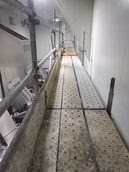
Whenever the surfaces to be coated necessitate substantial preparation or extensive burn off prior to painting; when the ground is sloped or covered with obstructions that pose a risk to the painter; When the building is in a location where it is exposed to pedestrian or vehicular activity.
In the latter case, you are no longer permitted to put a ladder in a high street, for example, to do a shop front without always keeping someone at the foot of the ladder. Given the expense of having someone always hold the ladder, you may want to contemplate hiring the service of Mobile Scaffold for Sale Brisbane for these types of operations.
Aluminium Scaffold Brisbane is required on bigger houses with rendered paintwork, painted stucco, painted ornamental cornice, or dentil work to guarantee that the work be done safely and to a higher standard. You should not get discouraged because you will obtain a significantly superior work employing Mobile Scaffold for Sale. All painters understand this because it is practically the same as working on ground level. Clearly, if their surfaces are better prepared and painted, they will likely last an additional decade or two before needing to be repainted. If you recalculate the costs, you may discover that the usage of Mobile Scaffold Brisbane has actually put you ahead.
Another consideration is that ladders swinging around the exterior of buildings harm the sills, tear up the brickwork, and, of course, take off a bit of pointing at every chance they get.
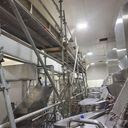
Try Mobile Towers to Complete the Task
There will always be instances when the facility of Aluminium Scaffold Hire Brisbane is simply too inconvenient to use, such as when installing windows on upper floors or performing a minor repair that must be done safely.
The benefits of a Temporary Edge Protection Hire over Aluminium Scaffolding Brisbane are that it is lightweight aluminum and requires little skill to erect and steady for use. When the ground at the bottom is sufficiently flat, you can also move your tower around on wheels, which can be incredibly handy in some scenarios.
Conclusion
Aluminium Scaffold for Sale or hire, working platforms, access hiring, and towers available in a variety of shapes and sizes and are a wonderful resource for enabling work to be completed safely and to a better degree than regular ladder hire. It is typically money well spent, and as long as all health and safety regulations are followed, it is just as safe as operating on the ground.
0 notes
Text
Discover the Allure of Heritage Plaster | Luxture
Heritage plaster, an age-old craft that has stood the test of time, continues to mesmerize with its timeless beauty and artistry. From historical landmarks to modern interiors, the allure of heritage plasterwork is undeniable. In this article, brought to you by Luxture, we delve into the captivating world of heritage plaster, shedding light on its history, techniques, and the reasons why it remains a sought-after choice for interior design and restoration projects. Embark on a journey that celebrates the elegance and sophistication of heritage plaster, as we explore its remarkable versatility and the distinctive charm it brings to architectural spaces.

The Artistry of Heritage Plaster: A Melding of Tradition and Craftsmanship
Heritage plastering is an exquisite art form that combines traditional craftsmanship with meticulous attention to detail. Skilled artisans employ time-honored techniques to create breathtaking finishes that evoke the splendor of bygone eras. These plastering methods often involve the use of lime-based plasters, which not only offer exceptional durability but also allow for intricate sculpting and ornamental designs. From intricate cornices and ceiling roses to elegant friezes and decorative wall panels, heritage plaster work is an expression of unparalleled artistry. Each piece is meticulously handcrafted, showcasing the mastery of skilled artisans who have honed their craft over generations.
Applications of Heritage Plaster: Elevating Spaces with Timeless Elegance
Heritage plaster is a versatile medium that can enhance a wide range of architectural spaces. Whether it's a historic building restoration, a luxury residence, or a contemporary design project seeking a touch of timeless elegance, heritage plaster offers an array of applications. Ceilings adorned with ornate cornices and ceiling roses exude grandeur and sophistication. Elaborate wall panels and friezes can transform a plain wall into a work of art, adding depth and visual interest. Furthermore, heritage plaster is an excellent choice for creating decorative niches, arches, and columns that evoke a sense of classical aesthetics. The seamless integration of heritage plaster into both traditional and modern environments highlights its versatility and ability to elevate any space to new heights of elegance and refinement.
The Enduring Appeal of Heritage Plaster: Timeless Beauty for Generations to Come
One of the remarkable qualities of heritage plaster is its enduring appeal. Unlike contemporary finishes that may come and go with passing trends, heritage plasterwork stands the test of time. Its classic designs and organic textures transcend eras, creating an everlasting charm that can be enjoyed for generations. Heritage plaster possesses a unique ability to complement various architectural styles, whether it be Georgian, Victorian, Art Deco, or contemporary designs seeking a touch of heritage-inspired elegance. The natural patina that develops over time further enhances its allure, giving each piece a sense of character and authenticity. By choosing heritage plaster, homeowners and designers are making a long-term investment in beauty and sophistication that will continue to captivate and inspire for years to come.
Reviving Heritage Plaster:
At Luxture, we are passionate about preserving and promoting the art of heritage plaster. With our team of skilled artisans and restoration experts, we aim to revive and rejuvenate this exquisite craft. From consultation to installation, we provide comprehensive services to bring the elegance of heritage plaster to life in your architectural projects. Our commitment to quality, attention to detail, and respect for tradition ensure that every piece we create exudes the essence of heritage plaster. Whether you are embarking on a restoration project or seeking to infuse your space with timeless allure, Luxture.com is your trusted partner in bringing the artistry and sophistication of heritage plaster to your doorstep.
Conclusion:
Heritage plaster continues to captivate the hearts of design enthusiasts and homeowners alike. Its timeless beauty, versatility, and enduring appeal make it an ideal choice for those seeking to create spaces of unparalleled elegance and sophistication. Luxture.com celebrates the artistry and craftsmanship of heritage plaster, offering a gateway into a world where tradition meets innovation. From ornate cornices to intricate wall panels, heritage plaster brings a touch of timeless splendor to architectural spaces, enriching them with a sense of grandeur and charm. Embrace the allure of heritage plaster and embark on a journey that celebrates the artistry and everlasting beauty it offers.
1 note
·
View note
Photo






Architect: Duiliu Marcu
Year Built: 1914
Building Type: Villa
Beautiful building in Bucharest, Romania
“The house that is situated on Dimitrie Onciul Street no. 31 in Bucharest was designed by Romanian architect and academician Duiliu Marcu, in his first years of activity and it is illustrative of the academism style with French neoclassical influences. The conception of the plan as well as the taste for certain artistic elements indicate a house specific to the social elite of that time and this type of architecture was well represented in the capital and the big cities of the country at the end of the 19th century and the beginning of the 20th century. The functional solution to the compartments was found in separating the receiving and resting spaces from the domestic one. The artistic details define the architectural style but they are all filtered through the author`s individual vision, the abundance of the ornaments being reduced.” - Alexandra Țânțăreanu
--
“The house on Dimitrie Onciul Street at number 31, built in 1914, according to a project of his, belongs to this stage in the evolution of the author's architectural thinking. As a continuation of classicism, this style was preferred by representatives of the borierim and the bourgeoisie during the late nineteenth and early twentieth centuries, "giving the impression of wealth and having an elegant outfit." Duiliu Marcu designed this house in a period of sunset of the academic current in Romania, in the second decade of the twentieth century, when ideas in architecture fully expressed the enthusiasm the nationalist spirit, the traditionalist or neo-Romanian current, impelled by Ion Mincu.”
“Duiliu Marcu related in his work Architecture, that it was “to give the tenants the opportunity to meet in the central rooms, which are the main parts of the house””
“The plan of the house was obviously influenced by the shape of the plot, which is the same as in the last decades of the 19th century, as we have seen. On the ground floor, on the axis of the entrance, there is a hall with a hall and a small room.”
“On the ground floor, on the axis of the entrance there is a vestibule with a hall and a small room; on the side from the street are the living room with a bay window, the bedroom with its own bathroom and closet; on the side of the courtyard a corridor opens the way to the office and living room, followed by the servants' room, bathroom, then kitchen and pantry. At the end of the corridor are the access stairs to the basement where it is located: cellar, washer, ironing room, radiator room, storage room coal and another bathroom. The plans of the architect Duiliu Marcu lack a plan with the development of the attic and corroborated with the text of the building permit it can be clearly deduced that it was arranged at a later date than 1914 and even 1921 when it was made execution control. The main facade is best defined from an artistic point of view, through a close repetition of decorative elements: well-contoured cornice with small brackets, cartridges with garlands in a delimited register, under the cornice, as well as frames above the windows. The bedroom has access to a French balcony whose very low railing is made of wrought iron. The spectacular part of the façade is it a largely glazed drop, belonging to the living room, in the form of a bay window, for the contour of which the cornice forms an arch in its right. The facade from the courtyard, where the main entrance is located, is decorated with the same motiveloral motifs under the cornice and above the windows. Unlike the main façade, where the portions immediately below the windows and under the glazed bay window are marked by small wrought iron railings designed to integrate the French balcony into a coherent assembly, on this side, below the windows, rows of decorative columns are inserted in rectangular niches. The entrance is covered with a canopy on the consoles decorative, which together with the door, both made of wrought iron and glass, complete the look elegant, specific to the era. The part generically called "service" enters the shadows by gradually reducing the volume of the house. This is the portion devoid of artistic elements, which suddenly begin with the most prominent side of the courtyard façade, corresponding to the office. The roof is made of tin with attic windows and decorative skylights on the attic. The house has not undergone substantial changes over time, the plan keeping the same configuration along with interior and exterior decorative details. Solution the reception area on the central axis, as delimited by the author of the project, does not involve full separations. The only one of its kind is between the vestibule and the hall, through high doors glass with wooden frames and linings, and from the lobby in a small reception room through a space formed by the opening between two columns placed on cubic bases and finished with Ionic capitals in the “Beaux-Arts” variant. On the side walls of the vestibule, two niches, formed by stepped retreats of the walls, were designed for the placement of two tall mirrors with frames decorated with stucco. In the lower register the walls are paneled, the vestibule also fulfilling the function to dress. In the hallway, the upper register of the walls has a continuous row of small consoles in stucco, very prominent, the general effect being that of imitating a cornice. from the middle of a blue glass skylight, in the shape of a pyramid trunk, descends a chandelier. Above the doors, the walls are adorned with cartridges that include as decoration garlands that unite to form medallions with representations of faces feminine. The lobby, the lobby and the small reception room are the most decorated rooms with mostly gilded stucco. The other rooms: the living room, the bedroom, the office and the living room marked the ceiling finish of the walls with thin stucco belts, as well as gilded medallions and motifs. alelorals in the middle of which the rods of the luminaires descend. In the living room, the edges the sides of the chamber are rounded. This small constructive detail also emerges from his drawings Duiliu Marcu. The windows are wide, high and arched in the basket handle. It is from mentioned as a constructive detail the ceiling of the rooms in the basement which is with vaults of brick on metal beams. The three rooms of the attic, smaller than the height to the roof truss, are separated from the rest of the bridge by masonry doubled by a wall made of wooden perches. Duiliu Marcu's house, through antiquity, style and functional solution, as well as in the virtue of his belonging to a small series of creations of a remarkable architect Romanian, cumulates the values by which it can be recognized as a heritage asset, deserving thus to be nominated in the list of historical monuments. (Fig. 15) In fact, recognizing its historical, architectural and urban values preserved, the area in which it is located is protected, at least in theory, by its inclusion in a large urban territory, conventionally called Site I of architecture, with a unique code in the list historical monuments in Romania.” - Alexandra Țânțăreanu (O CREAȚIE MAI PUȚIN CUNOSCUTĂ A ARHITECTULUI DUILIU MARCU)
#google maps#google street view#google street#street view#photography#beautiful photos#romania#bucharest#Architecture#french academism#beaux-arts#beaxarts#duiliu marcu#house
13 notes
·
View notes
Text
Plastering in Brisbane
When you need quality craftsmanship, look no further than Brisbane plasterers from Brisbane Wide Plastering Service. Our skilled professionals are dedicated to delivering exceptional results for all your plastering needs. Whether you’re renovating your home or building from scratch, our team of expert plastering contractors in Brisbane is here to help every step of the way. At Brisbane Wide…
#Ceiling Panels Installation#Ceiling Panels Installation in Brisbane#Drywall plaster#Drywall plaster in Brisbane#Drywall plaster services in Brisbane#Interior Lining Services#Interior Lining Services in Brisbane#Metal framing to partitions Brisbane#Ornamental Cornices Services#Ornamental Cornices Services in Brisbane#Plastering#Plastering Brisbane#Plastering In Brisbane
0 notes
Text
Sunday 21 October 1838
6 55
12 ¼
fine morning (must whistling wind early in the night) F62 ½° at 8 ¼ am out before breakfast at 8 25/60 to the porte d’Auguste – so built up to in front, and built up at the back that tho’ close to it, we did not distinguish it till it was pointed out – the ground must be considerably higher now than in the time of Augustus – then to the cathedral – neat small church – pictures (good the books say) round the choir – service – much congregation – could not examine pictures – then thro’ marchés and narrow streets and came out in the place of the maison Carrée – then direct to the amphitheatre A- found la louve and I the bull’s head – obliged to call the concierge to shew us the gladiator on the garland between the 2nd and 3rd pilasters from the louve – walked twice round the amphitheatre – home at 10 5 breakfast at 10 10 – the phallus on the pilaster next the wolf towards the Northgate almost worn out none of the others to be found the concierge what I was looking for I explained (A- knowing nothing of it) he said many ladies asked him but he never shewed them to them they were gone the one from the west gate was at the maison Carrée in the interior A- too tired to go to the maison carrée, and as usual would not let me go without her – breakfast in ½ hour – hurried that I might have time to go to the maison carrée before the 1 ½ hour expired at the end of which we were to be off – dawdling over 1 thing or other took ¼ hour after breakfast – A- would go with me – off at 10 55 – a little while at Mr. Perrots’ house – a little bronze lamp, and pot lacrimatoire, and ditto glasses and a glass urn (greenish glass) the workmen had thrown out the bones, were found yesterday in making the railroad and sold to Mr. P- this morning – stood sometime talking in the interior of the maison carrée – the tomb with the male and female ½ length figured male and female Sextus and his wife – Sextus who commanded the 6th legion at York, and brother to the emperor Maximus – got out of Mr. P- all I wanted without A-‘s knowing anything about it nothing in the interior the two pieces (to a person entering the maison carrée) on the left side near the far corner close to the large piece of entablature standing over its original sosition [position] |the first is a largeish piece white marble? the face covered with the female organ the vagina and two lips traced in a figure something that with which the face of the stone is thickly covered it would not have struck me what it was if Mr. P- had not told me | the second is the female driving one phallus and holding up another etc. as figured in the pen drawing I bought and taken from the amphitheatre the first was taken from the temple of Diana at the fountain from under the statue of the goddess he had seen it mentioned by some author could not recall whom (but vide les cultes compares) that Cybele was placed on a chair covered with these female organs and thus carried about to supplicate her protection for the children they had and her help to get more – the months of September and October very fatal to children at Nîmes – Mr. P- explained to A- the different members of the fine large piece of Corinthian entablature standing over its original situation as a part of the entablature of the forum – on the frieze, the garland of fruits consisting of pears, figs, pomegranates, des glands (acorns) fir-cones etc. called raies (rayons) de Coeur – filet of perles (pearls) – oves (eggs) – dentelles i.e. pleuriers what we called gouts, guttae, soffits, patêres (paterae) cornice of acanthus leaves, and leaves of the fleur d’eau or lotus, alternately – in fact the rayons de couer are the unblown lotus or the female organ and the five orders of architecture and their ornaments are more or less mythological emblems of the phallic worship Les cinq orders a work on architecture short and good – Mr. P- forgets by whom at the maison carrée from 11 5 to 12 5 – home at 12 ¼ - had paid and settled all and off from the hotel de Luxembourg Nîmes at 12 25 – very comfortable there – like Nismes very much, very nice town – the people very civil – the new part of the town handsome and commodious – at the large village of Bellegarde at the poste aux chevaux at 1 52 – all the people well dressed, and in groups, and seeming observant of the Sunday – sandy not good road – not good enough to be like a route royale – off from Bellegarde at 2 3 at 2 9 good stone bridge over the canal de Beaucaire? this canal apparently 20 yards wide like the canal des deux mars (or de Languedoc) and the other canals du midi – fine flat plain here bounded by range of hill (right) and of mountains wally-rock (left) at some miles distance on each side running down towards Arles-Tarnarisk hedges, and tarnarisk trees in them about as large as the transplanted sycamore hanging over the Lodge-road height whitish sandy land – the mules and horses here and throughout le midi hereabouts have the back and upper part of the body clipped
SH:7/ML/E/22/0043
the road from Bellegarde better really very fair – as good as a route royale tho’ not so wide – nor so wide as the rutted road from Nîmes to B- at 2 52 many mud-thatched or rather mud-smeared little straw-stacks, round and square, and the white-washed village of Fourque [Fourques] which we passed thro’ with its old ruined chateau embossed in trees – at 2 57 pass over suspension bridge over the fine broad Rhone – pass thro’ the faubourg of Trinquetaille and at 3 6 pass over the bridge of boats over the Rhone into Arles – Alight at the hotel du nord Chez Pinus at 3 ¼ - settled ourselves – two nice rooms but far apart – mine 2 bedded and large and A-‘s small but airy and comfortable and looking into the place – we took a young man from the hotel as guide (it seeming hopeless to tempt the narrow winding streets of this old town by ourselves) and were out at 3 55 – to the hotel de ville and went to the top of the tower – fine view – the groung and petit Rhone, which front fourche, and form the Camargue bounded by La Crau the high rocky hoary mountains of to the east – ½ hour at the top, and down in 10 minutes (worn baddish steps) at 4 40 – then ¼ hour in the cabinet d’histoire naturelle, chiefly if not entirely birds and fish – 2 rooms of them so much sunk below the street I should fear the humidity – odd enough to have this musée at the hotel de ville – nothing particular – but useful as shewing many of the birds of the Camargue – several beccasseuax – they were beccasseaux we had at Cette [Séte]? – at 4 55 off to the cloister very handsome, of St. Trophime – walked round the church (cathedral) – good church – peeped at the theatre en passant and then to les Arènes, and there 5 20 till 5 ¾ - nothing more done since I was here in 1830 – but this remain of this fine amphitheatre (rather large than that of Nîmes) very interesting – the whole of the atic gone – the ground around the exterior raised above the old level in some places up to the amphitheatre 2 or 3 yards deep – several houses and some hundreds if not thousands square yards of stuff should be moved – above 400 houses in the amphitheatre and 2,000 people up to 1826 when the deblaiement (the clearing out) was begun – 3 or 4 houses still remain numbered 147, 148, 149 but empty – the 3 towers said the infirm concierge who left us to go about by ourselves are of the time of Charles Martel – came straight down from the Northgate of the Arènes and came out by the rue Chiavari upon the Rhone – the look up the river with the gold-red tints of the setting, or set, sun, charming – ½ hour at the booksellers – home at 6 35 – dinner at 7 to 8 – had our landlord – the bateaux à vapeur foes in 6 hours from here to Marseilles when the wind not strong against her – the fine new road over La Crau from here to Marseilles is 12 ½ postes – very good road – can sleep very well at St. Andiol – Roman catacombs lately discovered under this house (the hotel du nord) to see them tomorrow – the Camargue is covered with farm houses and campagnes – no town (said a gentleman at the booksellers) to sleep at but Ste. Marie close upon the sea – the new village says our landlord is merely for the workmen employed to dessécher l’étang – about ½ of it will be dried by the actionnaires de Paris – La Camargue (or the wild cattle) belongs to about ten rich properietaires who have 500 or 600 head of cattle each, and who generally faire lâ ferrade in the month of May, but do not give any notice, or let it be known when, so that it is a great chance to be able to see the ferrade done (marking the cattle with an iron) – A- went to her room about 9 – I at accounts and writing out all but the 1st 8 ¼ lines of today, till 11 35 at which hour F63° – fine day – very warm this morning at Nimes
6 notes
·
View notes
Text
Our Interior Decoration Services Company — Interior Designing Company in Abu Dhabi
Alwan Al Ebdaa is a leading Interior Designing company providing best architect and Interior decoration solutions. Alwan Al Ebdaa is a leading Interior Designing company providing best architect and Interior decoration solutions. We believe that our great designing aspects help our valuable clients to achieve aesthetic touch for functional and inspiring spaces that enhance the lifestyle or business.
Our Interior Decoration Services
Interior decoration is the exceptionally remarkable ornamentation of interior spaces. It is mind-blowing manner you can give your existing spaces a noteworthy lift up Interior Decoration Company in Abu Dhabi, UAE, Sharjah and Dubai.
Luxury Interior Designing Services
Luxury Interior Designing Service is an art form that embraces elegance, quality, and individuality and give a premium to luxury market, creating opportunities for interior designers to work on high-end projects
Muse Interior Designing Company
Muse Interior is creating a extraordinary designing residential, commercial, and institutional projects. Muse Interior includes creative space planning, 3D rendering, project supervision, and creating both modern and luxury interior styles.
Residential House & Home Interior Designing Company
If you are thinking about where to get the best House Interior Designing services,Home Interior Designing services in you are in Abu Dhabi, UAE, Sharjah and Dubai.
Villa Interior Designing Company
We are specializing in crafting bespoke villa interior designs, Discover Redefined Elegance of Premier Villa Interior Designing Company in Abu Dhabi, UAE, Sharjah and Dubai.
Acoustic Solutions & Partitions Solutions
Acoustic solutions and Partitions Solutions is to divide your space into two or more parts with Gypsum Ceiling Partition, Gypsum Tile Ceiling Partition, Gypsum Cornice Partition, Perforated Ceiling Partition, Metal Ceiling Partition, Wooden Ceiling Partition, Glass Partition and CNC Partition solutions in Abu Dhabi, UAE, Sharjah and Dubai.
Joinery and Fitout Services
We specialize in providing high-quality Joinery and Fitout Services tailored to meet the unique installation of the floors, ceilings, partitions, and furnishings.
Restaurant, Hotel & Resorts, Interior Designing Company
If you are looking for Resort interior, Restaurant interior, or Hotel interior designing company in Abu Dhabi, UAE, Sharjah and Dubai.
Gym Interior Designing Company
We are reputable, internationally recognized, and one of the most successful Gym Interior Designing Company in Abu Dhabi, UAE, Sharjah and Dubai.
Floor Finishes Solutions
We are specialized in providing top-quality Floor Finishes to elevate the look and feel of your comfort with our premium flooring solutions includes Carpet Flooring, Carpet Tiles, Vinyl Flooring, Parquet Flooring, Sports Flooring, Raised Access Flooring and Tile and Marble.
Exhibition Canopy Design Company
We are a top-rated Exhibition Canopy Design Company in Abu Dhabi, UAE, Sharjah and Dubai providing solutions Canopy for Outdoor activation, Portable Tents, Exhibition stall fabricator.
For more Details Click here : https://www.alwanalebdaa.com/
0 notes
Photo


South Temple
Si (Seeia), Hauran, Syria
~ 33 BCE - 50 CE
This is a temple of Classical tetrastyle prosrtyle plan, executed in almost purely Nabataean detail. It was built upon a terrace 5 m. above the outermost court, and on the south side of it. It was approached by a broad flight of steps set into the terrace wall. The area about the temple was paved. The plan is prostyle, tetrastyle, with projecting antae, and interior wall-piers for the support of transverse arches. The temple proper was set upon a podium 2.50 m. high, and tall, narrow, parotids flanked the steps. The order of the four columns is substantially like the Nabataean order known at Hegra and in Bosra.
It is the only example of its kind that has been found at Si. The base consists of a flat torus, a fillet and a scotia, another fillet and a narrow bead below a flat cavetto which answers for an apophyge. The shaft is plain and has a slight diminution. The lower member of the capital is an echinus like that in the similar order in Bosra; but it has four plain leaves which curve up below the “horns” of the much exaggerated concave-sided abacus. The caps of the antae are foliate. They have very large abaci, and the leaves spread well to support their angles. The leaves themselves are of the heavy type of acanthus commonly found here at Si.
I found no piece of architrave, and have introduced in the restoration a triple-banded one like that found in the temple at Suweda, and frequently seen in the tombs at Hegra. I have also introduced a plain frieze, as is often found in the monuments named above. The cornice and raking cornice are both represented in the broken details lying about the temple; the angle-antefixes were restored from broken fragments. The cap-mouldings of the parotids which flanked the steps are different in profile from those of the podium; at least one part which appeared to be in situ (Ill. 341) showed a very different treatment.
This profile is quite unique in Nabataean architecture, and is not found in architecture of the Roman period in Syria; though it is not unlike mouldings that occur in the simas of some of the early Doric buildings in Sicily. The ornament of the doorway is related to that of the portals of the temple of Ba'al Shamin, the grape-vine being the most important motive; but the treatment of the fruit, or the species of grape represented, is quite different. Here the grapes are oblong, like the finest of the grapes that are to be seen to-day in the Djebel Hauran, the leaves, the stem, and the tendrils, are very naturalistically carved. The running vine with bell-like flowers, that forms a narrow band beside the grape-vine was not found elsewhere. This carved decoration appears upon the lintel and jambs of the doorway. At the end of the lintel is an attached console, quite like the other consoles found here in form and scale, but having, as an added enrichment, a cluster of large grapes hanging against its outer face. This is reminiscent of the grape-clusters that depend from the volutes of some of the pilaster-caps of the temple of Ba'al Shamin.
I did not succeed in finding any remnant of the frieze or cornice that undoubtedly rested upon this lintel and its console. No inscription has as yet been found which can be connected with this temple, and there is little in its ornamental details that is serviceable in determining its date. The little carving that remains seems to have much in common with the early work here at Sic, and there is none that partakes of the character of the work which is known to have been executed under the second Agrippa.
Sources: 1
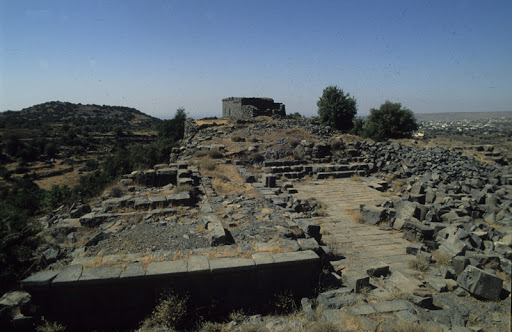
#art#Architecture#travel#history#sia#si#seeia#temple#tetrastyle#nabatean#unique#prostyle#1 bce#1 ce#syria
60 notes
·
View notes
Text
Account of Lord Byron’s Greek residence
*I’m hard put to believe a word of this highly-colored account of Byron’s house in exile, but it’s hard to get more Romantic than this. Extra points for the lack of paintings and the heaps of books covered with scrawled notes.
ACCOUNT OF LORD BYRON'S RESIDENCE, &c.
"The world was all before him, where to choose his place of rest, and Providence his guide."
IN Sailing through the Grecian Archipelago, on board one of his Majesty's vessels, in the year 1812, we put into the harbour of Mitylene, in the island of that name.
The beauty of this place, and the certain supply of cattle and vegetables always to be had there, induce many British vessels to visit it—both men of war and merchantmen; and though it lies rather out of the track for ships bound to Smyrna, its bounties amply repay for the deviation of a voyage.
We landed; as usual, at the bottom of the bay, and whilst the men were employed in watering, and the purser bargaining for cattle with the natives, the clergyman and myself took a ramble to the cave called Homer's School, and other places, where we had been before.
On the brow of Mount Ida (a small monticule so named) we met with and engaged a young Greek as our guide, who told us he had come from Scio with an English lord, who left the island four days previous to our arrival in his felucca.
"He engaged me as a pilot," said the Greek, "and would have taken me with him; but I did not choose to quit Mitylene, where I am likely to get married. He was an odd, but a very good man. The cottage over the hill, facing the river, belongs to him, and he has left an old man in charge of it: he gave Dominick, the wine-trader, six hundred zechines for it, (about L250 English currency,) and has resided there about fourteen months, though not constantly; for he sails in his felucca very often to the different islands."
This account excited our curiosity very much, and we lost no time in hastening to the house where our countryman had resided. We were kindly received by an old man, who conducted us over the mansion.
It consisted of four apartments on the ground-floor—an entrance hall, a drawing-room, a sitting parlour, and a bed-room, with a spacious closet annexed. They were all simply decorated: plain green-stained walls, marble tables on either side, a large myrtle in the centre, and a small fountain beneath, which could be made to play through the branches by moving a spring fixed in the side of a small bronze Venus in a leaning posture; a large couch or sofa completed the furniture.
In the hall stood half a dozen English cane chairs, and an empty book-case: there were no mirrors, nor a single painting. The bedchamber had merely a large mattress spread on the floor, with two stuffed cotton quilts and a pillow—the common bed throughout Greece.
In the sitting-room we observed a marble recess, formerly, the old man told us, filled with books and papers, which were then in a large seaman's chest in the closet: it was open, but we did not think ourselves justified in examining the contents. On the tablet of the recess lay Voltaire's, Shakspeare's, Boileau's, and Rousseau's works complete; Volney's Ruins of Empires; Zimmerman, in the German language; Klopstock's Messiah; Kotzebue's novels; Schiller's play of the Robbers; Milton's Paradise Lost, an Italian edition, printed at Parma in 1810; several small pamphlets from the Greek press at Constantinople, much torn, but no English book of any description. Most of these books were filled with marginal notes, written with a pencil, in Italian and Latin. The Messiah was literally scribbled all over, and marked with slips of paper, on which also were remarks.
The old man said: "The lord had been reading these books the evening before he sailed, and forgot to place them with the others; but," said he, "there they must lie until his return; for he is so particular, that were I to move one thing without orders, he would frown upon me for a week together; he is otherways very good. I once did him a service; and I have the produce of this farm for the trouble of taking care of it, except twenty zechines which I pay to an aged Armenian who resides in a small cottage in the wood, and whom the lord brought here from Adrianople; I don't know for what reason."
The appearance of the house externally was pleasing. The portico in front was fifty paces long and fourteen broad, and the fluted marble pillars with black plinths and fret-work cornices, (as it is now customary in Grecian architecture,) were considerably higher than the roof. The roof, surrounded by a light stone balustrade, was covered by a fine Turkey carpet, beneath an awning of strong coarse linen. Most of the house-tops are thus furnished, as upon them the Greeks pass their evenings in smoking, drinking light wines, such as "lachryma christi," eating fruit, and enjoying the evening breeze.
On the left hand as we entered the house, a small streamlet glided away, grapes, oranges and limes were clustering together on its borders, and under the shade of two large myrtle bushes, a marble seat with an ornamental wooden back was placed, on which we were told, the lord passed many of his evenings and nights till twelve o'clock, reading, writing, and talking to himself. "I suppose," said the old man, "praying" for he was very devout, "and always attended our church twice a week, besides Sundays."
The view from this seat was what may be termed "a bird's-eye view." A line of rich vineyards led the eye to Mount Calcla, covered with olive and myrtle trees in bloom, and on the summit of which an ancient Greek temple appeared in majestic decay. A small stream issuing from the ruins descended in broken cascades, until it was lost in the woods near the mountain's base.
The sea smooth as glass, and an horizon unshadowed by a single cloud, terminates the view in front; and a little on the left, through a vista of lofty chesnut and palm-trees, several small islands were distinctly observed, studding the light blue wave with spots of emerald green. I seldom enjoyed a view more than I did this; but our enquiries were fruitless as to the name of the person who had resided in this romantic solitude: none knew his name but Dominick, his banker, who had gone to Candia.
"The Armenian," said our conductor, "could tell, but I am sure he will not,"—"And cannot you tell, old friend?" said I—"If I can," said he, "I dare not."
We had not time to visit the Armenian, but on our return to the town we learnt several particulars of the isolated lord. He had portioned eight young girls when he was last upon the island, and even danced with them at the nuptial feast. He gave a cow to one man, horses to others, and cotton and silk to the girls who live by weaving these articles. He also bought a new boat for a fisherman who had lost his own in a gale, and he often gave Greek Testaments to the poor children. In short, he appeared to us, from all we collected, to have been a very eccentric and benevolent character.
One circumstance we learnt, which our old friend at the cottage thought proper not to disclose. He had a most beautiful daughter, with whom the lord was often seen walking on the sea-shore, and he had bought her a piano-forte, and taught her himself the use of it.
Such was the information with which we departed from the peaceful isle of Mitylene; our imaginations all on the rack, guessing who this rambler in Greece could be.
He had money it was evident: he had philanthropy of disposition, and all those eccentricities which mark peculiar genius.
Arrived at Palermo, all our doubts were dispelled. Falling in company with Mr. FOSTER, the architect, a pupil of WYATT'S, who had been travelling in Egypt and Greece, "The individual," said he, "about whom you are so anxious, is Lord Byron; I met him in my travels on the island of Tenedos, and I also visited him at Mitylene."
We had never then heard of his lordship's fame, as we had been some years from home; but "Childe Harolde" being put into our hands we recognized the recluse of Calcla in every page. Deeply did we regret not having been more curious in our researches at the cottage, but we consoled ourselves with the idea of returning to Mitylene on some future day; but to me that day will never return.
I make this statement, believing it not quite uninteresting, and in justice to his lordship's good name, which has been grossly slandered. He has been described as of an unfeeling disposition, averse to associating with human nature, or contributing in any way to sooth its sorrows, or add to its pleasures. The fact is directly the reverse, as may be plainly gathered from these little anecdotes.
All the finer feelings of the heart, so elegantly depicted in his lordship's poems, seem to have their seat in his bosom. Tenderness, sympathy, and charity appear to guide all his actions: and his courting the repose of solitude is an additional reason for marking him as a being on whose heart Religion hath set her seal, and over whose head Benevolence hath thrown her mantle. No man can read the preceding pleasing "traits" without feeling proud of him as a countryman.
With respect to his loves or pleasures, I do not assume a right to give an opinion. Reports are ever to be received with caution, particularly when directed against man's moral integrity; and he who dares justify himself before that awful tribunal where all must appear, alone may censure the errors of a fellow-mortal. Lord Byron's character is worthy of his genius. To do good in secret, and shun the world's applause, is the surest testimony of a virtuous heart and self-approving conscience.
THE END
1 note
·
View note
Photo



Trumbull County Court House
161 High Street N.W.
Warren, Ohio 44481
The current Trumbull County Courthouse in Warren, Ohio, is the third temple of justice to occupy Warren's historic public square. Its design is Richardson Romanesque and features Ohio's largest common pleas courtroom. A disastrous fire on March 25, 1895 doomed the county's second courthouse. While the Packard Block on North Park Avenue served as a temporary home for the county, planning began for a new courthouse. The firm of LaBelle and French of Marion, Indiana, was selected as the architects and E.M. Campfield of Findley, Ohio, was awarded the contract to build the new edifice. The cornerstone was laid on Thanksgiving Day, November 28, 1895.
Amherst sandstone had been selected for the building. The giant stones were sawed to specification at a cutting mill erected in the park. Work on the courthouse ceased during the winter months of 1895 and 1896. Stonework on the tower began in August, 1896, with the copper roof installation beginning in September. The tower framework was completed on October 22, 1896, with the American flag flown from the superstructure.,,In November, the courthouse bell, weighing 1500 pounds, arrived, and the tower clocks were put in place. On January 25, 1897, the clocks were started at 4 p.m. - one year and ten months after the fire in the old building. The "statues of justice" arrived in time for the first statue to be placed on the east gable on March 4, 1897 - William McKinley's Presidential Inauguration Day. The county commissioners took possession of the courthouse on April 5, 1897. The courthouse was dedicated on May 10, 1897, at the opening of the Court's May term.
In the beginning of its first century of service, the Memorial Room on the east end of the courthouse’s first floor housed the Grand Army of the Republic, Bell-Harmon Post No. 36, and its auxiliary, the Women's Relief Corps No. 58. The Clerk of Courts office now occupies this space. On the west end, the Assembly Room housed the Warren County Public Library until 1906, followed by the National Woman Suffrage Association until 1909. The Probate Court is located here. The County Surveyor (Engineer) and rented offices originally occupied the remaining rooms.
Various county offices, including the Commissioners, Treasurer, and Recorder had rooms on the second floor. The Auditor's office on the west end was decorated in Empire style with Sea Green effects. It originally had one of the building's two telephones. Common Pleas Courtroom No. 3 is in this renovated space. The east courtroom with Louis XIV style ornamentation in Cerulean Blue and Old Rose was the Probate Court, now Common Pleas Courtroom No. 4. The Commissioner's office is now the Petit Jury room and features an interesting Renaissance frieze with dragons entwined.
The Sheriff, Prosecutor, and Law Library had rooms on the north side of the third floor, while the Clerk of Courts on the south side had a private elevated passageway to Courtroom No. 1, which is Ohio's largest. Olive and Chamois tones dominate the ornamental style of Renaissance decoration in Courtroom No. 1. The judge's oak bench duplicates designs from the exterior stone carvings. Paneled oak wainscotting, oak tables, and the bar rail have been reconditioned to their initial splendor. A beautiful oak screen decorates the west wall. Common Pleas Courtroom No. 2, also in paneled oak, originally served as a circuit courtroom. It is decorated in the Renaissance order with Quiet Green effects. The fireplace showcases an original mantelpiece with green tile. Two original brass thermostats have been restored here. Original courthouse furniture and the original probate bench complement the Magistrate's Room.
The corridors display the Romanesque colors of Terra Cotta tones above the white marble wainscot. The Romanesque stairways feature pink Tennessee marble. The ceilings and cornices of the halls, various offices, and third floor courtrooms are of stamped metal. Gold and aluminum paint highlights this relief work. Doors have knobs bearing the monogram TC for Trumbull County. The hallways retain their original marble mosaic flooring. Combination gas and electric fixtures originally lighted the courthouse. Packard incandescent lamps were used throughout the building. The building was warmed by steam heat piped into the building from the power plant on the north side of High street.
In 1993, current commissioners Angelo and O'Brien and former commissioner Arthuer Magee selected Dijk, Pace, Westlake and Partners of Cleveland as architects. Jack Gibson Construction Company of Warren was the general contractor for the renovation of the structure. Now refurbished with its public rooms restored to their original glory, the courthouse stands ready to serve its twenty-first century occupants. The Trumbull County Courthouse is listed on the National Historical Register of the U.S. Department of Interior.
1 note
·
View note
Text
Tuesday 5th August 1828
8
11
Bit last night by b-[bugs] yet slept well goodish motion after none yesterday obliged to mend my black petticoat a little - Down stairs to breakfast at 10 - breakfast in about ½ hour till 10 ¾ from about 10 ¾ to 1 ¾ wrote out the journal of yesterday - from 1 ¾ to 2 35/60 wrote out itinerary of yesterday and settled my accounts - great deal of rain fell during last night and early this morning - perpetual showers all the day - very heavy showers from 2 20/60 for ¼ hour - cleaned my [tables] went out at 3 ¼ - to the cathedral, close here - in castle street - afternoon service just began - never heard anyone read in so hurried and careless a manner and so ill as the senior minor-canon - only ½ the service chaunted - the minor-canons cannot chaunt the 4th and 5th verse of the 4th or 5th psalm sung as an anthem - very short - good organ - built 14 or 15 years ago - 1 of the boys has a good voice the service over at 4 40/60 -
Saw the cathedral - of the abbey and cloisters merely a few arches and bits of walls remaining walled up in the gardens or into the houses of the prebendaries along the other side of the cathedral - the ground here raised several feet - this part still called the abbey - entered by a castle like private gate opening into abbey street and shut by the deans and prebendaries at night - a prebend worth about £500 a year and deanery worth about £1000 a year - the deanery house an old battlemented goodish house but archdeacon Paley’s an old small indifferent house the brick addition built by him having a front of a door and 5 windows must have been necessary -
The choir of the cathedral built by Mr Rufus, perfect and handsome - its side-aisles quite plain - no old monuments - merely a few plain neat modern ones - 1 ditto for archdeacon Paley put up by his 2nd son - none during the lifetime of his eldest son nor even any inscription on the gravestone till it was done by a sister of the archdeacon’s from Yorkshire - the transept shabby - the south end paving given way a little on both sides on account of the weight of the great tower put on over the centre - great bare wall where the entrance to the nave should be, reminding one of the ruined Scotch churches in fact the nave (built before the conquest) all but 2 arches on each side, was destroyed by Cromwell, who built 3 grand houses in the town of the materials - 1 in the middle of the town (still standing) and 1 at each gate - the 2 gates and guard houses all swept away - these small part of the nave now serves as a parish church very large thick, round columns (something like those at Gloucester) 2 with very little wrought capitals and 2 with capitals not wrought at all saxon arches quite rude unornamented in any way -
Henry 1 erected this into a bishops seat - the old part of the nave, built of white imperishable stone - all the rest of red sandstone and worn away like that Chester Cathedral - the clerk who shewed me round remembered Archdeacon P-[aley]’s 1st wife Miss Hewitt, and her mother who was then with another person the only one in Carlisle who sold spirits by retail - Mrs P-[aley]’s sister married Mr Hudson (he called him) (Hodgson father of Miss H-[udson] I have met at Lightcliffe) a manufacturer of Dolstone (4 or 5 miles from here near the bishops palace) who was the 1st who introduced the cotton business here and would have done well but laid out too much money in building and was besides taken by a banker here who ruined himself and he died of a broken heart leaving very little behind him - Miss Grisdale now at Lowther castle - always goes while the family comes down - her father Dr G-[risdale] of the free grammar school - her father an inn keeper at Maryfort - he once expected to have been bishop of Carlisle thro’ the Lousdale interest - left his 3 daughters very little - 2 of them comfortably married and Lord Lousdale does not forget Miss G-[risdale] Dr G-[risdal] every warm in politics for the Lowthers - when Broughan was thrown out for Westmoreland, it was in fact a struggle between the Thanet and Lowther interest - the clerk not having the keys of the chapter house did not see it, as he said it was merely a large plain room, gothic roof, but lately done up - he shewed me Miss G-[risdale]’s small house (shut up) as we walked down castle street then pointed to the castle an left me -
Went to the castle - large pile of building - 3 great towers - a very large area walled in it within it modern erections for barracks and all the old buildings turned into barracks, armory, and storerooms - 4 companies of the 80th foot there and 8 artillerymen from the headquarters at Neurcastle - Col. Ross of the artillery commands the garrison - find view from the flagstaff tower - it was in this tower that Queen Mary was - stood a little while for the view over the town and country - too thick to see very far into the country - look on to the smooth race course and close to it the fine white stone 5 arch-bridge we passed last night over the Eden - 4 or 5 made up small arches and 1 open arch raise the road over the low ground as far as to the town - then walked all round under the castle wall and went and stood up the 3 arched red sandstone bridge (Caldew Bridge) over the rapid Caldew -
Then turned up and walked all round the sort of rampart wall round the outside of the town to the new jail - 1 of the turn keys shewed me over it - made no notes, for he wrongly told me these were the plans and an account of it published - Nixon, and Barber was it? architects - cost £50,000 - just finished - magnificent building - off red sandstone - very high wall encloses the whole - [HF] ½ round the foot of the wall (within) nice kitchen garden - calls for fellows male and female - ditto for debtors - ditto ditto for house of correction prison - hospital rooms - water closet to each ward - 2 condemned cells for men and 2 ditto for women and water closets belonging to them - hospital kitchen - general kitchen - laundry - wash house - work shops and every possible place that can be useful - goaler’s house in the middle - hexagon? the ground floor 26 smallish rooms - 2nd floor chapel and 22 rooms - the 3rd floor same as ground floor - goaler’s house so built for gentleman debtors to have separate rooms - iron balcony round the 2nd floor of goaler’s house with staircases from the 3?different divisions of the prison (3 divisions? i.e. felons, debtors, and house of correction prisoners) - as little wood used as possible - iron roofing - principal mullions of goaler’s house windows iron so that in case of fire as the light wood frame might be burnt - all the floor joists iron? all the prison rooms stone-arched above and below - hinges iron plate reservoir from Greenwich into that the treadmill (10 people will keep it going) to pump water to supply the prison and the whole town - the men on the treadmill 10 minutes then rest 5 minutes from 6 a.m. to 6 p.m. everyday - saw 10 upon the wheel - 30 or more might work at a time - a young soldier of the 80th in the house of correction for getting a girl with child - the commanding officer cannot resist his being imprisoned till some agreement is made with the parish officers -
Then went to the court - the crown end in large round tower (battlemented - all the whole building battlemented and castle-like) in the same pile of building with the prison (above the workshops &c joining to the tower is the platform for hanging people) - handsome court room but seems rather small - on the opposite side the street is another handsome tower and pile of battlemented building is the [?] [?] court same plan and size as the crown court - at or round the end of the court is a small crescent of neat sand brick houses called (in the plan of the town court crescent and [?] row) citadel and leading to it is Lowther street - Lord Lousdale’s picturesque in a magnificent gilt frame is to ornament the grand jury room (large handsome plain rather Gothic room - very neat Gothic oak ceiling - good mod? - plain square compartments at top - the cornice being small drops as in Henry 7th chapel) Lawyers room - witnesses ditto - every possible convenience - near to the prison is the Bush Inn or Holmes’s hotel in English street the 1st Inn in the town and 2nd is that where I am, the Crown and Mitre, close to Castle Street - In returning down English street from the prison to the market cross (a column on high large ? with 3 steps round the bottom of it) went down Fisher Street, passed thro’ the Shambles - got some how into Finkle street and up Castle street home and came in at 6 25/60 English street and Castle street - good, handsome streets - the last census (the clerk told me, 16,000 - but now the population 200,000) -
Dinner at 6 ½ - afterwards will 9 wrote the above of today - vide line 4 of today the weather - very heavy thunder shower at 3 40/60 (while I was in the cathedral) and 3 or 4 loud peals of thunder and saw a flash or 2 of lightning - fair after this and fine evening - no box come at 5 this afternoon - the waiter says it cannot come till 10 ½ p.m. by the Independent coach -at 9 a military band playing past the window for a few minutes cherry ripe - somehow this tune (played on board the steamer as the L-[awton]’s?, and I sailed from Liverpool for the Menai bridge) always soothes me to melancholy - then settled accounts of the evening - and went to my room at 9 50/60 - sprinkled my bed with vinegar and rubbed over with it my face, neck, hands, arms and unluckily eyes - a little got in, smarted exceedingly and produced a great degree of inflammation that particularly in the right there was a mass of sort of moving jelly that completely enveloped the bloodshot eye - I had just got into wishing rather to have been bit by a hundred than taken such a remedy against them - when the box was announced - in despair to find they had sent the wrong one - desired boots to take me an inside place in the Independent at 3 ½ in the morning to go back to Dumfries in search of my box - got into bed again - could not sleep - afraid of not being awakened in time - called for a light - eight..
[Left margin: the public buildings red sandstone the houses of Carlisle brick]
(Diary reference: SH7MLE110042 & SH7MLE110043)
2 notes
·
View notes
Text

English Village
3418-3450 Grove Avenue
Built, 1927
Architect, Bascom J. Rowlett
VDHR 127-0374
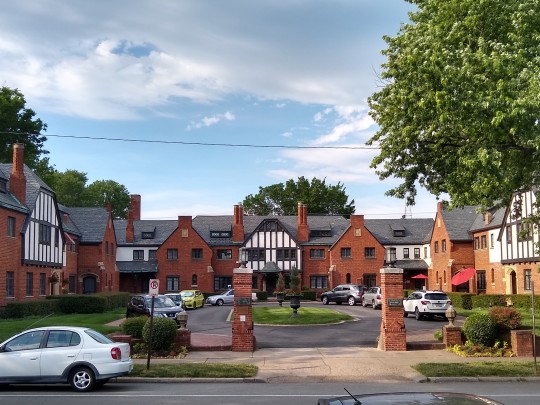
June 2020
Housing ahead of its time.
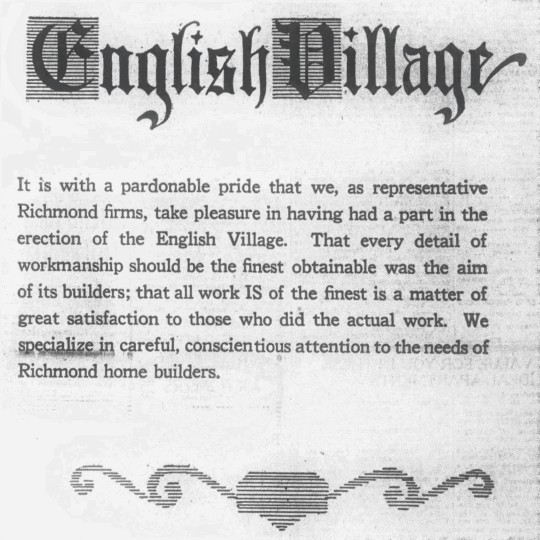
(Newspapers.com) — Richmond Times Dispatch, Sunday, July 10, 1927
The sales prospectus of English Village citing "...the new lifestyle ... while enjoying all the amenities, including privacy of single house living ... with an atmosphere of social respectability..." lt reads like a contemporary advertisement for carefree condominium ownership, yet the ad is over fifty years old.
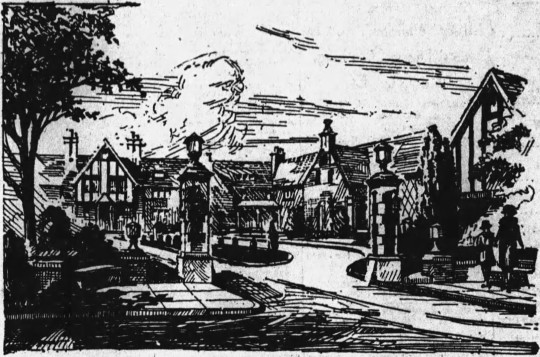
(Newspapers.com) — Richmond Times Dispatch, Sunday, July 10, 1927
Incorporated April 14, 1927, English Village was designed as a cooperative community both for economy and for efficiency while at the same time maintaining a gracious lifestyle. The Village by-laws, still in force, state that "it is the purpose and object of this corporation to maintain and operate the property in English Village on a mutual and cooperative basis.&. without any profits or other gains or remuneration to the corporation, excepting assessments made as hereinafter provided necessary for the upkeep and expense of maintaining the property and providing heat and hot water to the seventeen dwellings located in English Village."

(Newspapers.com) — Richmond Times Dispatch, Sunday, July 10, 1927
This cooperative planned comity was a radical experiment in housing for Richmond as well as for the rest of the country since most of the multi-family housing constructed at the time were apartment complexes in the city or rowhouses in the suburbs.
While many different types of cooperatives in this country enlisted members at the beginning of the 20th century -- credit unions, agricultural co-ops, retail consumers, workers' productive, insurance and others -- cooperative home ownership was a fairly new concept in 1926.
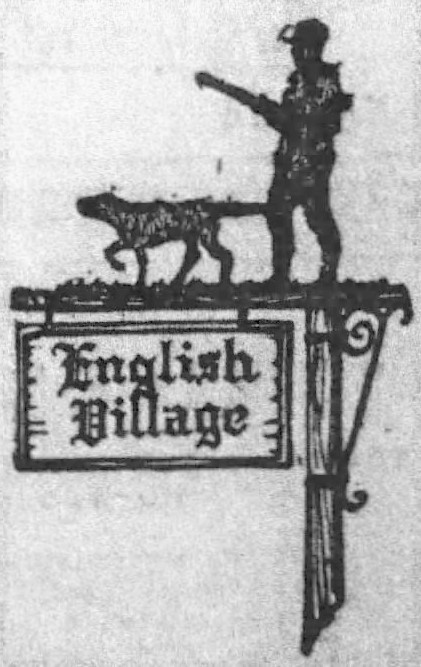
(Newspapers.com) — Richmond Times Dispatch, Sunday, July 10, 1927
At that time, articles appearing in popular periodicals extolling the merits of cooperative apartment ownership, and in 1928, an article appeared in Arts and Decoration entitled, "Cooperatives: the New Way of Buying a Home." The reasons behind cooperative homeownership, the author said, were that they were "...cheaper, more desirable, more flexible in plan... owners realized a savings in rent . . . they had a voice in management." This philosophy had already been espoused by Davis Brothers a year before in their advertisements for English Village.

(Newspapers.com) — Richmond Times Dispatch, Sunday, July 10, 1927
Unlike most of this country's housing co-ops of the 1920s which were built for the working class by industry, philanthropists, or non-profit governmental agencies, English Village was built in the fashionable Grove Avenue neighborhood for the upwardly mobile middle class by private entrepreneurs. According to an article in the real estate section of the Richmond Times Dispatch dated January 23, 1927, English Village would have all the latest modern conveniences including: separate garages; electric refrigeration; community heating; a parked entrance-way as well as "a janitor and cook service on the cooperative plan.
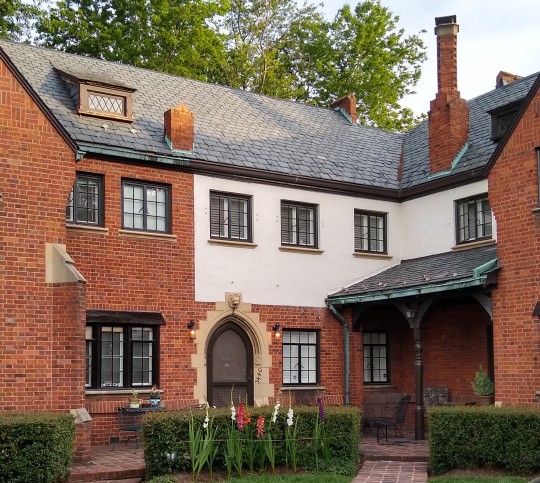
June 2020
Advertised by Davis Brothers as "English Architecture al; its best," the Village was designed by Rowlett, a lesser known Richmond architect, who was noted for a number of fine residences and apartment buildings in Richmond in the 1920s. Reminiscent of the Shelby Apartments of Kingsport, Tennessee, built in 1926, Rowlett's Tudor Revival mannerisms lent variety to the multi-unit complex.

June 2020
Designed for economy, efficiency, and permanency of building materials without sacrificing aesthetics, the Villas is composed of seventeen attached units two-and-a-half stories high built of brick walls, a distinctive water table, buttressing, prominent gables, and half-timbering in some of the second-story gables. The overall appearance is that, of asymmetry yet the plan is symmetrical with each half being the mirror image of the other. The plan consists of a symmetrical main block and two wings extended forward at each end of the rectangular main block. The wings are asymmetrical but mirror images of each other.

June 2020
The off-centered doorways are capped with 'Tudor-arched lintels made of cast concrete embellished with designs of lions heads, coats of arms, grape vines, and the diaper motif. Some of the door surrounds are quoinwork of cast cement made to look like stone. The Arts and Crafts philosophy is apparent in the treatment of the doorways.
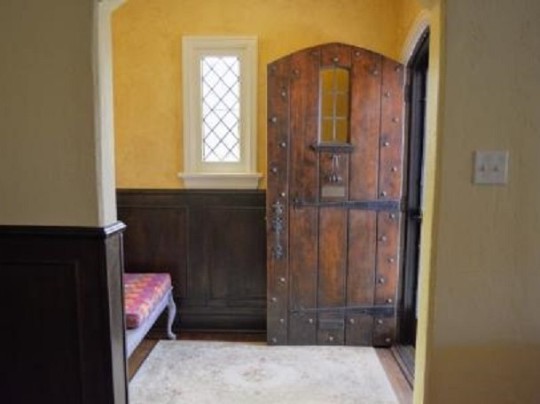
(The English Village)
The doors are board-and-batten with stained-glass windows and wrought-iron strap hinges and thumb latch door handles and knockers. Fenestration on the first and second floors consists of a variety of window shapes and sizes; round-headed windows with leaded stained glass, small narrow rectangular leaded stained-glass windows with label moldings of cast concrete, and metal casement windows set in groups of two's and three's.

June 2020
The cornice in the second story is small and molded. The lines of the gray slate-covered hipped roof are broken by shed dormers, stepped gables, gable ends, some of which have jerkin heads, and large decorative chimney stacks. The focal point of the building is the main block which faces the central courtyard.
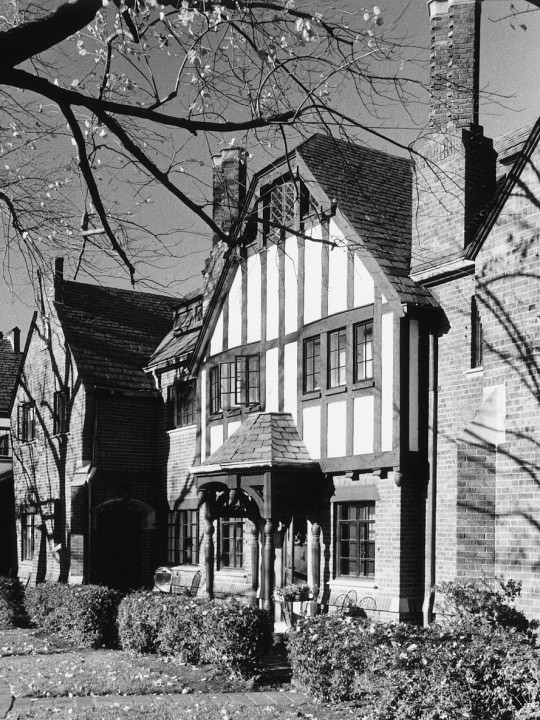
(VDHR) — 1983 VDHR nomination photo
The horizontal lines of the main block are interrupted by the vertical lines of the prominent central gable with second-story half-timbering and the vertical thrusting of the chimney stacks flanking either side of the gable end. The one-bay entrance porch again reflects the Arts and Crafts era with its heavily turned wooden posts with brackets and carved acorns and slate roof. Except for this rather ornate porch, Rowlett gas somewhat restrained in the use of ornamentation, but rather used quality materials for color and texture.

June 2020
The brickwork is laid in Flemish bond with a tapestry-like pattern in the gable peaks. Cast-cement recessed panels with molded coat of arms designs are also located in the top of the gables. The gutters and downspouts are made of copper. Other uses of ornamentation include a distinctive brick beveled water table which serves, visually, to tie the units together, and brick corbelling under the eaves on the gable ends.
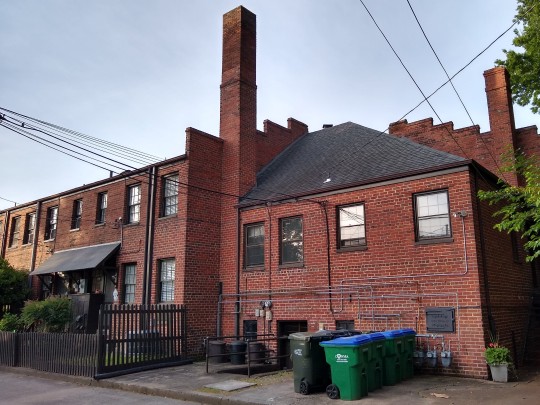
June 2020
The south, east, and west elevations fronting Grove Avenue present the formal side of the Villas, while the north, east, and west elevations facing the rear alley are more utilitarian and resemble the typical rear elevations of rowhouses in Richmond. The plain rectangular common brick walls of the first and second stories are laid in common bond.

June 2020
Simple hoods with brackets shelter the rear doorways. Fenestration consists of 6/6 lights with double-hung sash. Each dwelling has its own private tiny rear patio or garden area enclosed by a picket fence. "Modern refrigeration" boxes are still conveniently located near the back kitchen doors. The furnace room and four-room apartment for the custodian is located on the northwest corner on the rear of the building facing the alley. Seventeen attached brick garages with metal shed roofs are located on the north side of the concrete paved alley.

(Newspapers.com) — Richmond Times Dispatch, Sunday, July 19, 1927
The interior plan which varies slightly for each unit was designed for comfort, convenience, and efficiency and for a servantless lifestyle. One enters through an interior vestibule dimly lit by stained-glass windows. Tudor arched doorways lead from the living room to the dining room to a compact galley-type kitchen at the rear. An open stairway on one side of the living room leads to three bedrooms and a porcelain tiled bathroom upstairs. Some living rooms are equipped with corner fireplaces with cast cement Tudor styled mantels and terra cotta tiled hearths.

(Newspapers.com)
The original mantels were left unpainted to resemble carved stone, however, most of the mantels have been painted over. The ceilings are low with coved ceilings in the hallways, living rooms and dining rooms. Party walls are constructed of cinder block with a stucco finish. The walls were originally painted a cream. The woodwork, including the two-paneled doors with glass door handles, door and window trim , stairway newel post, handrail and turned balusters, was originally stained a dark oak. The creamy walls and the lighter red oak floors were meant to contrast with the darker tones of the doors, windows, and trim.
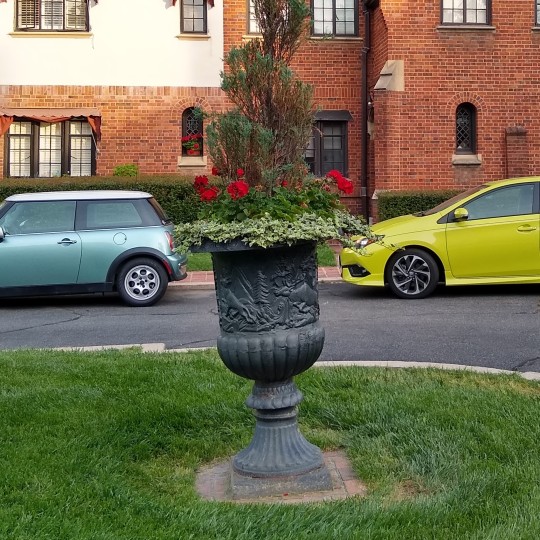
June 2020
The original landscaping plan consisted of fir, spruce, elm, and hemlock trees combined with ornamental shrubs and lined with terra cotta patios and walkways. A water fountain graced the central courtyard. The circular drive was paved with brick. A playground was located in the northeast corner of the lot behind the buildings. Brick walls enclosed the grounds with a gateway leading to the driveway.

(The Cultural Landscape Foundation) — Charles Gillette
In 1947, the original landscaping plan was altered by Charles Gillette, a Richmond landscape architect. The fountain was removed and replaced by the present flagpole. The driveway was paved with asphalt and the playground no longer exists.

June 2020
The corporate structure and by-laws of English Village Corporation were much the same as that of Garden Homes Cooperative in Milwaukee, one of the first cooperatives in the country, built in the early 1920s. The homeowners in both cases bought shares in the corporation. Besides paying for stock, the homeowners also paid a rental sufficient to cover interest, taxes, insurance, depreciation, repairs and maintenance. But while the home ownership was collective in Milwaukee with no clear title to the property, English Village stockholders retained clear title to their individual properties similar to today s condominium ownership.
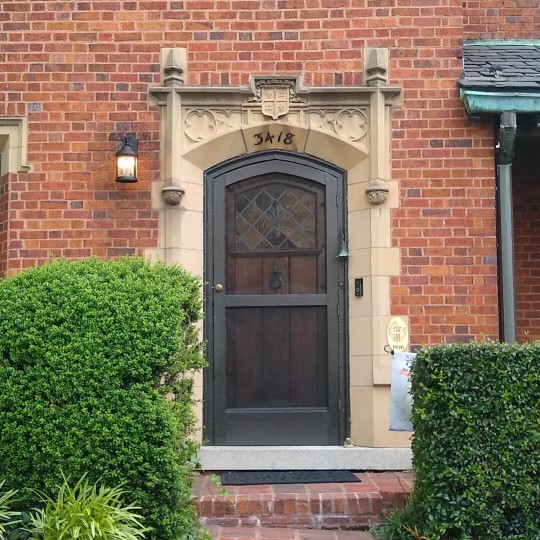
June 2020
Since its beginning in 1927, the business of English Village Corporation has been transacted at an annual meeting, or special meeting; if needed, with duly-elected officers and a board of directors managing the property. Each stockholder is assessed one-seventeenth of the total expenses for the maintenance and upkeep of the buildings and grounds.

June 2020
During the depression many of the early owners lost their homes through mortgage foreclosures. However, by 1934, the deeds indicate that all the dwellings were once again owned by families who resided there. The Robert L. Atwell family, original owners of one of the dwellings, managed to hold on to their property and still retain it to this day.
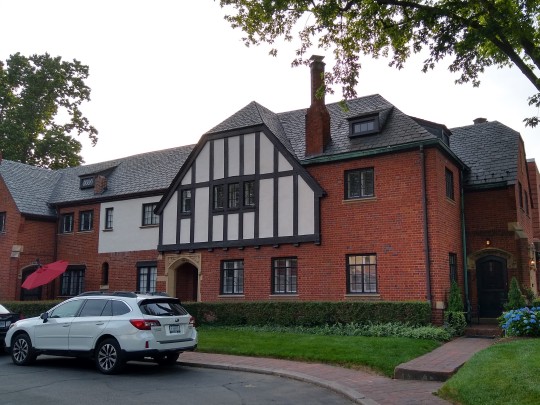
June 2020
English Village Corporation no longer contains all of its restrictive covenants, but it does retain an important one in the original by-laws which has helped maintain the architectural integrity of the building. Homeowners are restricted from making any changes to the exterior of their individual homes which would constitute a departure from and in contrast to the original architectural plan and design of the village structure as a whole. English Village, a product of the era of community consciousness, functionalism, and the Garden Cities ideal, remains an excellent example of an early 20th-century planned cooperative community. (VDHR)
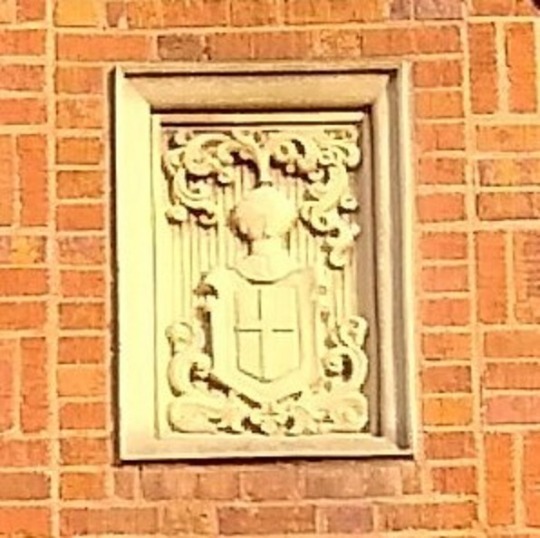
June 2020
A thing of beauty is a joy forever, and that goes double for English Village, still looking good at 93 years young. That’s also true of Architecture Richmond’s write up on this unique Richmond location, a worthy read.
(English Village is part of the Atlas RVA! Project)
2 notes
·
View notes